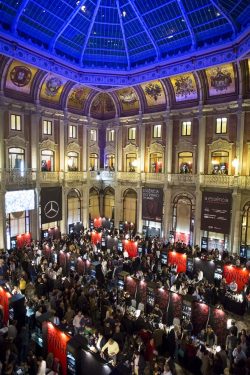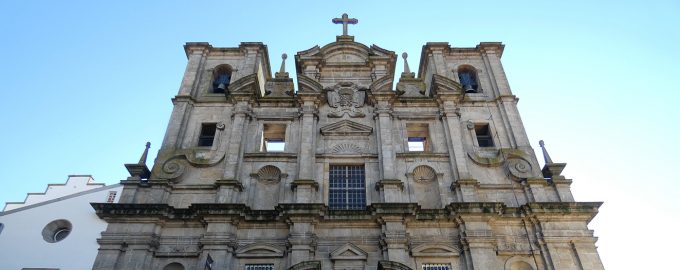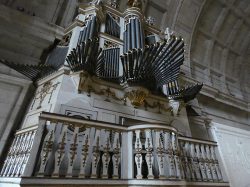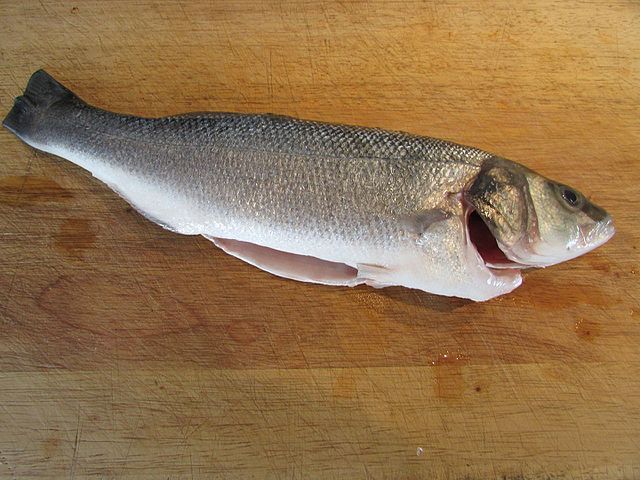 Created for the first time in 2004, ESSÊNCIA DO VINHO – PORTO is an organization of Essência do Vinho and Revista de Vinhos, in partnership with the Associação Comercial do Porto, which is held once again at the Palácio da Bolsa from 21st-24th February. The last edition of the event received over 20,000 visitors, 35% of which were foreigners.
Created for the first time in 2004, ESSÊNCIA DO VINHO – PORTO is an organization of Essência do Vinho and Revista de Vinhos, in partnership with the Associação Comercial do Porto, which is held once again at the Palácio da Bolsa from 21st-24th February. The last edition of the event received over 20,000 visitors, 35% of which were foreigners.
Promoted since 2004, this event is considered as the main wine experience in Portugal, testing thousands of references from around the world and promoting a program that includes dozens of activities carefully planned to offer a unique experience to all who participate , from producers to professionals and consumers.
In this 16th edition, participants will be able to discover and be amazed by the possibility of tasting over more than 3,000 wines from 400 producers, from all Portuguese and international wine regions, in one of the highlights of the event that allows establishing or developing contacts with key players of the industry and know the backstage steps of production.
Four days dedicated to the knowledge and awakening of senses, with rare and exclusive labels presented by renowned experts invited to masterclasses, commented evidence, , the sharing of experiences and tasting of snacks, in a relaxed atmosphere.
Amongst the masterclasses and tastings mentioned, the highlight being the “TOP 10 Portuguese Wines – Wine Magazine”, which will bring together a selection of the best wines by a prestigious international jury of the Wine Magazine in the Arab Hall of the Palace of the Stock Exchange. Composed of journalists, wine critics and sommeliers, the panel will choose the best white wines, the best red wines and the best fortified wines.
 WINE ESSENCE – PORTO will be held from February 21st, from 3:00 p.m. to 8:00 p.m., on the 22nd and 23rd from 3:00 p.m. to 9:00 p.m. and on February 24th from 3:00 p.m. to 8:00 p.m., in a joint organization by Essência do Vinho and Revista de Vinhos, in partnership with Associação Comercial do Porto. Tickets for ESSÊNCIA DO VINHO – PORTO are now available at www.essenciadovinhoporto.com/pt/informacoes-uteis.
WINE ESSENCE – PORTO will be held from February 21st, from 3:00 p.m. to 8:00 p.m., on the 22nd and 23rd from 3:00 p.m. to 9:00 p.m. and on February 24th from 3:00 p.m. to 8:00 p.m., in a joint organization by Essência do Vinho and Revista de Vinhos, in partnership with Associação Comercial do Porto. Tickets for ESSÊNCIA DO VINHO – PORTO are now available at www.essenciadovinhoporto.com/pt/informacoes-uteis.
The admission costs € 20 daily and includes a Riedel tasting glass.
Tickets bought on site on the days of the event will cost € 25.


 Restaurants
Restaurants Hidden secrets
Hidden secrets
 In the Church stand out the beautiful altar of Our Lady of Purification, the fantastic organ with 1500 tubes that, according to records was built at the end of the century. XVIII and the crib, a unique construction, dating from the XVIII century and whose authorship is attributed to Machado de Castro. At Christmas time, along with the tradition of many other churches in the city, it is possible to appreciate this very rare crib composed of large dozens of figures placed right at the entrance of the monument.
In the Church stand out the beautiful altar of Our Lady of Purification, the fantastic organ with 1500 tubes that, according to records was built at the end of the century. XVIII and the crib, a unique construction, dating from the XVIII century and whose authorship is attributed to Machado de Castro. At Christmas time, along with the tradition of many other churches in the city, it is possible to appreciate this very rare crib composed of large dozens of figures placed right at the entrance of the monument.
 In this new year of 2019, celebrating 500 years of the first circumnavigation trip, I decided to present a fusion cuisine dish.
In this new year of 2019, celebrating 500 years of the first circumnavigation trip, I decided to present a fusion cuisine dish.
 eggs. With herbs, shaves and reductions. Textures and flavors. Elements. Juices. Aromas. The shrimp and the mackerel, shrimp and pigeon seem out of a fable. And the rabanada that closes the meal is a metaphor that reminds us that what is perfect does not need anything. It is through small insignificances that Vasco travels in search of perfection. In a smoked chicken broth to season a squid. In a low temperature yolk to make a rolled ticket sublime. In a carabineiro juice that gives a divine touch to a prawn açorda. In the gum of a carolino rice berry. Or that bread that Rui kneaded. A must repeat to those who’ve been there. A discovery for those who love the elegance of good food and have not yet found the best destination for this purpose in the very noble and unconquered city of Porto
eggs. With herbs, shaves and reductions. Textures and flavors. Elements. Juices. Aromas. The shrimp and the mackerel, shrimp and pigeon seem out of a fable. And the rabanada that closes the meal is a metaphor that reminds us that what is perfect does not need anything. It is through small insignificances that Vasco travels in search of perfection. In a smoked chicken broth to season a squid. In a low temperature yolk to make a rolled ticket sublime. In a carabineiro juice that gives a divine touch to a prawn açorda. In the gum of a carolino rice berry. Or that bread that Rui kneaded. A must repeat to those who’ve been there. A discovery for those who love the elegance of good food and have not yet found the best destination for this purpose in the very noble and unconquered city of Porto The green Porto. In the park. It could be in the City. Listening through plantains the whispers of Nick Cave pushing the sky. Or in Serralves. Go through the Clareira das Azinheiras with Richard Serra. Cross the Alameda with Claes Oldenburg. Contemplate the sky in the Roseiral with Anish Kapoor and the Sky Mirror. Feel the caress of light on the Lake and the Meadow. And end up in the Tea House as Lou Reed to drink sangria in the Park and sing “Oh It’s such a perfect day, I’m glad I spent it with you”.
The green Porto. In the park. It could be in the City. Listening through plantains the whispers of Nick Cave pushing the sky. Or in Serralves. Go through the Clareira das Azinheiras with Richard Serra. Cross the Alameda with Claes Oldenburg. Contemplate the sky in the Roseiral with Anish Kapoor and the Sky Mirror. Feel the caress of light on the Lake and the Meadow. And end up in the Tea House as Lou Reed to drink sangria in the Park and sing “Oh It’s such a perfect day, I’m glad I spent it with you”. Miró is back home. In Serralves. Some works from the collection of the Portuguese State, you will find paintings from the Miró and Mapfre Foundations collection. An exhibition focused on the period leading up to Miró’s grand retrospective at the Grand Palais in Paris in 1973. Tension and anger at the death of painting. Creation and destruction. Trimmed frames. Burned. Murdered. Die to be reborn, to reinvent. New materials. Ready made art. Bags, buckets, boxes of wine. Some works that were not shown for nearly forty years. And the Sobreteixims we already know of “Materiality and Metamorphosis”. “Miró and the Death of Painting”. Another great exhibition in Serralves. We are waiting for you until 3 March.
Miró is back home. In Serralves. Some works from the collection of the Portuguese State, you will find paintings from the Miró and Mapfre Foundations collection. An exhibition focused on the period leading up to Miró’s grand retrospective at the Grand Palais in Paris in 1973. Tension and anger at the death of painting. Creation and destruction. Trimmed frames. Burned. Murdered. Die to be reborn, to reinvent. New materials. Ready made art. Bags, buckets, boxes of wine. Some works that were not shown for nearly forty years. And the Sobreteixims we already know of “Materiality and Metamorphosis”. “Miró and the Death of Painting”. Another great exhibition in Serralves. We are waiting for you until 3 March.
 The Lighthouse-Chapel of São Miguel-O-Anjo was the first lighthouse built from scratch in Portugal and one of the first in the world. It was built in 1527 in the area of the Cantareira, by order of D.Miguel da Silva – King’s ambassador to the Pope, Bishop of Viseu and Abbot Commander of the Monastery of Santo Tirso.
The Lighthouse-Chapel of São Miguel-O-Anjo was the first lighthouse built from scratch in Portugal and one of the first in the world. It was built in 1527 in the area of the Cantareira, by order of D.Miguel da Silva – King’s ambassador to the Pope, Bishop of Viseu and Abbot Commander of the Monastery of Santo Tirso. The viewpoint of Santa Catarina is, simultaneously, the width of the Chapel of Santa Catarina and Senhora dos Anjos, high in the parish of Lordelo do Ouro. The wide, welcoming area is surrounded by a stone wall that protects us from the cliff and invites us to approach.
The viewpoint of Santa Catarina is, simultaneously, the width of the Chapel of Santa Catarina and Senhora dos Anjos, high in the parish of Lordelo do Ouro. The wide, welcoming area is surrounded by a stone wall that protects us from the cliff and invites us to approach.
 One needs to start this journey with their belly lined. Create a wall that is prepared to protect us from the aggressions that we are about to endure. For this, there is no better than a Francesinha. The place? Requinte, still in Matosinhos, which promises to protect all those who venture out in Porto.
One needs to start this journey with their belly lined. Create a wall that is prepared to protect us from the aggressions that we are about to endure. For this, there is no better than a Francesinha. The place? Requinte, still in Matosinhos, which promises to protect all those who venture out in Porto. Adega Sports, Adega D.Leonor and 77 are the mandatory stops. Also, these places are not eternal and when their closure begins it is time of indecisions: go for a little dance or call it a night. For those who are willing to make their night epic, in my opinion, there is only one place to go: Boo. Refined space, many stories, where we are well served and well received, with the music of vogue and an environment of more or less general madness. However, for the less adventurous, the Rendez Vous or Porto Tónico are always good places to stretch your legs. These never disappoint and are a safe haven of leisurely play.
Adega Sports, Adega D.Leonor and 77 are the mandatory stops. Also, these places are not eternal and when their closure begins it is time of indecisions: go for a little dance or call it a night. For those who are willing to make their night epic, in my opinion, there is only one place to go: Boo. Refined space, many stories, where we are well served and well received, with the music of vogue and an environment of more or less general madness. However, for the less adventurous, the Rendez Vous or Porto Tónico are always good places to stretch your legs. These never disappoint and are a safe haven of leisurely play.



